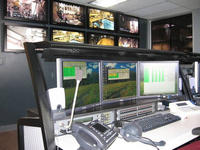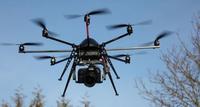-
Lawmaker proposes restrictions on domestic drone use
Senator Rand Paul (R-Kentucky) on Tuesday introduced legislation into the Senate which he says aims to protect individual privacy against unwarranted governmental intrusion through the use of the unmanned aerial vehicles commonly known as drones
-
-
Day of wide-spread domestic drone use nears
So far, the U.S. Federal Aviation Administration( FAA) has issued 266 active testing permits for civilian-drone applications, but has yet to allow drones wide-scale access to U.S. airspace; law enforcement and industry officials say that it is only a matter of time before the FAA would allow the more than 18,000 law enforcement agencies and departments to begin to use drones for surveillance
-
-
California bill prohibiting use of license plate readers dies in state Senate

Facing growing pressure from law enforcement agencies in the state, and a concerted effort by technology and insurance companies, the sponsors of a bill which would prohibit the use and storage of License Plate Recognition (LPR) data, decided not to bring the bill to a vote on the California Senate floor
-
-
Improving automated monitoring of security camera networks

Police and security teams guarding airports, ports, and border crossings from terrorist attack or illegal entry need to know immediately when someone enters a prohibited area, and who they are; a network of surveillance cameras is typically used to monitor these at-risk locations twenty-four hours a day, but these can generate too many images for human eyes to analyze; a new approach uses mathematics to perform this analysis more accurately and in a fraction of the time it would take a human camera operator
-
-
NASA to operate unmanned aircraft over hurricanes this year
Beginning this summer and over the next several years, NASA will be sending unmanned aircraft dubbed “severe storm sentinels” above stormy skies to help researchers and forecasters uncover information about hurricane formation and intensity changes
-
-
Can UAVs emulate bats’ flight capabilities?
The natural world has countless examples of creatures with extraordinary flight capabilities, but bats have evolved with truly extraordinary aerodynamic capabilities that enable them to fly in dense swarms, avoid obstacles, and fly with such agility that they can catch prey on the wing, maneuver through thick rainforests, and make high-speed 180 degree turns; researchers want to know whether UAVs can emulate bats
-
-
DHS forced to release list terms it monitors on social media
Following a Freedom of Information Act (FOIA) request by the Electronic Privacy Information center (EPIC), DHS was forced to release its 2011 Analyst’s Desktop Binder; the binder, among other things, contains a list of words DHS uses as triggers of suspicious communication when the department’s analysts monitor social media
-
-
First response, law enforcement UAVs, robot markets to grow
Training and simulation account for $13.73 billion in spending by the U.S. Department of Defense budget in 2012, roughly 2 percent the DoDs total budget, and UAV training is a not-insignificant part of that budget; first-responder robot markets, valued at $440.4 million in 2011, are anticipated to reach $1.6 billion by 2018
-
-
UAV flight training and simulation market to reach $451.9 million in 2012
The proliferation of UAVs, and their utility on the modern battlefield, will see demand for the services they offer continue to rise into the next decade; this demand will be accompanied by a requirement for more skilled UAV pilots and sensor operators
-
-
FAA moves on integrating drones into U.S. airspace

The Federal Aviation Administration (FAA) now allows a government public safety agency and first responders to operate drones weighing 4.4 pounds or less in the U.S. air space, but under certain restrictions: these drones should be used for training and performance evaluation, they must be flown within the line of sight of the operator, less than 400 feet above the ground, during daylight conditions, inside Class G (uncontrolled) airspace, and more than five miles from any airport or other location with aviation activities; the FAA says that if safety agencies then apply for a waiver, the agency will allow the operation of drones weighing up to twenty-five pounds
-
-
FBI seeking wiretap-ready Web
As communications have changed in recent years from the traditional telephone system to the Internet, the FBI has found itself facing greater difficulty in carrying out surveillance operations; the agency is asking Internet companies not to oppose a coming proposal which would require them to provide a surveillance backdoor
-
-
Flying robots equipped with 3D gear: better surveillance on the cheap

Whether deployed to create virtual maps of difficult-to-access areas, monitor construction sites, measure contamination at nuclear power plants, assess conditions in a disaster-ravaged area, or identify rowdy soccer hooligans, mini UAVs could be used in a wide range of applications, obviating the need for expensive aerial photography or satellite imaging
-
-
DARPA wants technology to see through clouds
Soldiers who encounter enemy forces on the ground benefit from overhead aircraft support; some capabilities are lost, however, when cloud-cover obscures the view; DARPA is seeking advanced, flyable electronics and scene simulation technology for video synthetic aperture radar
-
-
Reason-based behavioral recognition system wins award
A reason-based behavioral recognition system for video surveillance developed by Houston, Texas-based BRS Labs wins an award at London’s Counter Terror Expo
-
-
Seattle police takes steps to quell drone concerns
The Seattle Police Department recently acquired a small camera-equipped drone, but it remains unused while city policymakers work to calm privacy concerns
-
- All
- Regional
- Water
- Biometrics
- Borders/Immig
- Business
- Cybersecurity
- Detection
- Disasters
- Government
- Infrastructure
- International
- Public health
- Public Safety
- Communication interoperabillity
- Emergency services
- Emergency medical services
- Fire
- First response
- IEDs
- Law Enforcement
- Law Enforcement Technology
- Military technology
- Nonlethal weapons
- Nuclear weapons
- Personal protection equipment
- Police
- Notification /alert systems
- Situational awareness
- Weapons systems
- Sci-Tech
- Sector Reports
- Surveillance
- Transportation
Advertising & Marketing: advertise@newswirepubs.com
Editorial: editor@newswirepubs.com
General: info@newswirepubs.com
2010-2011 © News Wire Publications, LLC News Wire Publications, LLC
220 Old Country Road | Suite 200 | Mineola | New York | 11501
Permissions and Policies
Editorial: editor@newswirepubs.com
General: info@newswirepubs.com
2010-2011 © News Wire Publications, LLC News Wire Publications, LLC
220 Old Country Road | Suite 200 | Mineola | New York | 11501
Permissions and Policies
